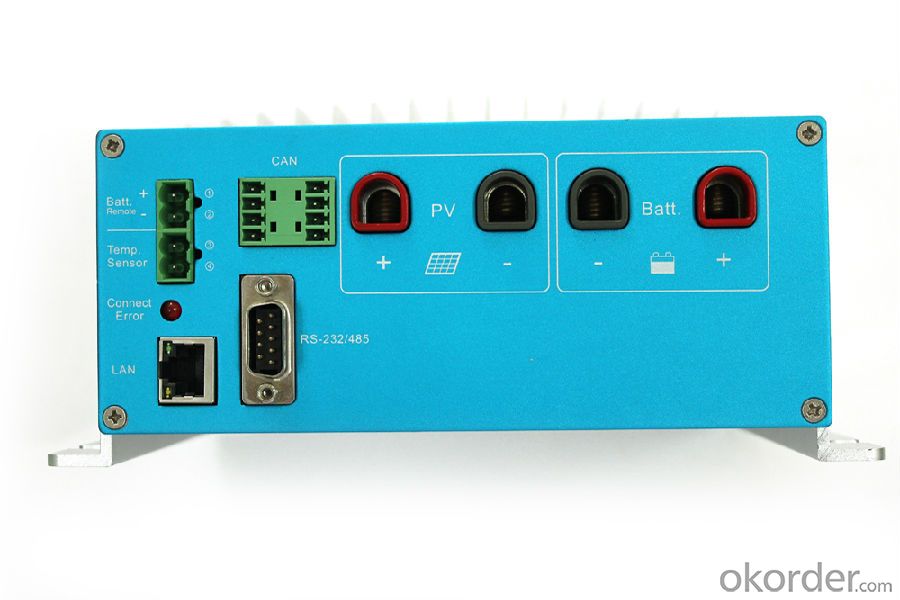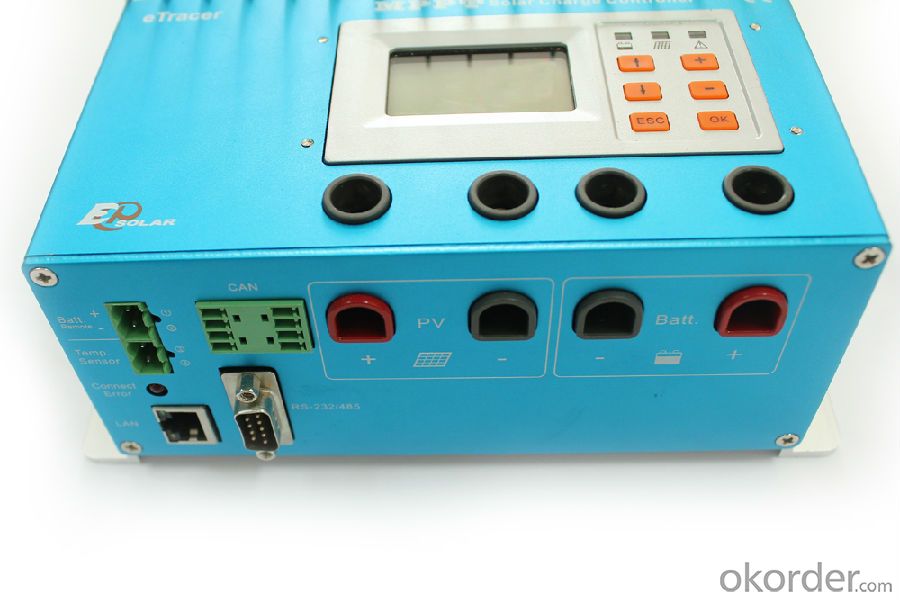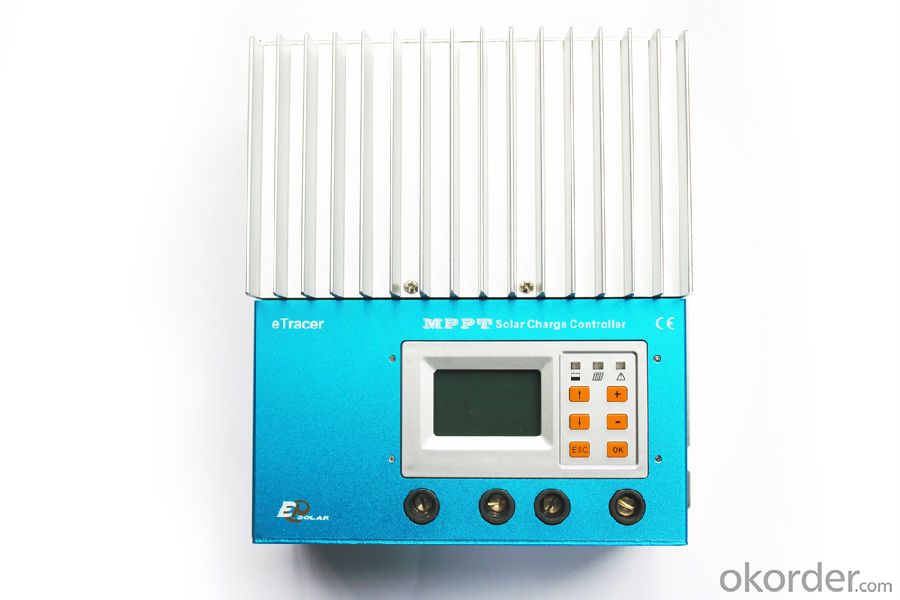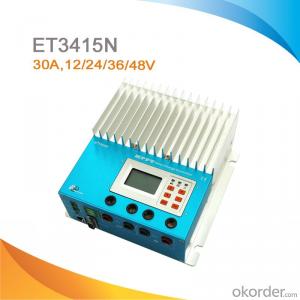MPPT Solar Panel Charge Controller 30A,12/24/36/48V,ET3415N
OKorder Service Pledge
OKorder Financial Service
You Might Also Like
Specifications
MPPT charge controller
Maximum power point tracker
temperature compensation
LCD display
Communicate with PC
Features:
·12/24/36/48V auto work
·Advanced MPPT technology
·Several seconds tracking speed
·High Tracking efficiency of 99%
·Multiphase synchronous rectification technology
·Peak conversion efficiency of 98%
·DSP&ARM processors architecture ensures high speed and performance
·Gel, Sealed, Flooded battery option
·Max. 450 days data logging by connection to PC
·Multifunction LCD displays system data and status
·Three kinds of communication ports :RS232, CAN BUS and Ethernet
·Three stages charging optimizes battery performance
·Software update by users
Electronic Protections:
·PV short circuit protection
·PV reverse polarity protection
·PV overvoltage alarm protection
·PV over current protection
·Battery overcharge protection
·Battery over discharge protection
·Battery reverse polarity protection
·Overheating protection
Specification:
Model | ET3415N | ET4415N | ET6415N |
Rated system voltage | 12V/24V /36V/48V auto work | ||
Rated battery current | 30A | 45A | 60A |
Max. PV open circuit voltage | 150V | ||
Voltage range | 8~72V | ||
Max.PV input power | 400W (12V) | 600W (12V) | 800W (12V) |
800W (24V) | 1200W (24V) | 1600W (24V) | |
1200W (36V) | 1800W (36V) | 2400W (36V) | |
1600W (48V) | 2400W (48V) | 3200W (48V) | |
Self-consumption | 1.4~2.2W | ||
Grounding | Negative | ||
Dimension | 231x203x105mm | 285x203x105mm | 285x203x121mm |
Terminal | 35mm2 | 35mm2 | 35mm2 |
Net Weight | 4.1kg | 4.4kg | 5.0kg |
Working temperature | -25℃~+55℃ | ||
Storage temperature range | -30℃~+85℃ | ||
Humidity | 10%-90% NC | ||
Enclosure | IP20 | ||
Altitude | ≤3000m | ||



FAQ:
Q1. What is the voltage?
A1. Our 45/60A solar charge controller is 12/24/36/48V auto work.
Q2. What is the difference between MPPT&PWM?
A2. MPPT has higher efficiency, it can track the max power point and won't waste energy.
Q3. What is the efficiency of the MPPT controller?
A3. MPPT>99%, peak conversion efficiency>98%.
Q4. What is the waranty of product?
A4. 12 months.
Q5. What protection does your MPPT controller have?
A5. PV array short circuit, PV reverse polarity, Battery reverse polarity, Over charging, Output short circuit.
- Q:Can a solar controller be used in a mobile solar power system, such as an RV or boat?
- Yes, a solar controller can definitely be used in a mobile solar power system such as an RV or boat. In fact, it is highly recommended to use a solar controller in such systems to ensure efficient and safe charging of the batteries. A solar controller, also known as a charge controller, is designed to regulate the flow of solar energy from the solar panels to the batteries. Its main purpose is to prevent overcharging and over-discharging of the batteries, which can lead to damage and reduce their lifespan. In a mobile solar power system like an RV or boat, where the solar panels are exposed to varying sunlight conditions and the batteries are constantly being charged and used, a solar controller becomes even more important. It helps optimize the charging process by adjusting the voltage and current to match the battery's requirements, thereby maximizing the charging efficiency. Furthermore, a good quality solar controller will also have additional features like temperature compensation and load control. Temperature compensation ensures that the charging parameters are adjusted based on the ambient temperature, which helps prevent any potential damage to the batteries. Load control allows you to connect additional loads to the system, such as lights or appliances, and ensures that they are powered directly from the solar panels without draining the batteries. In summary, a solar controller is an essential component in a mobile solar power system like an RV or boat. It helps regulate the charging process, protects the batteries, and maximizes the efficiency of the solar energy utilization.
- Q:How do you protect a solar controller from lightning strikes?
- One effective way to protect a solar controller from lightning strikes is by installing a surge protection device (SPD) at the point where the solar panels connect to the controller. This SPD helps to divert the electrical surge caused by lightning strikes away from the controller, ensuring its safety. Additionally, grounding the entire solar system and using proper lightning rods or conductors can further minimize the risk of damage from lightning strikes. It is essential to consult with a professional electrician or a solar installer to ensure proper installation and protection measures are in place.
- Q:How does a solar controller handle battery temperature monitoring and protection?
- A solar controller handles battery temperature monitoring and protection by constantly monitoring the temperature of the battery. This is typically done by using a built-in temperature sensor or by connecting an external temperature sensor to the controller. The controller measures the temperature of the battery and compares it to a predefined temperature range. If the temperature falls outside of this range, the controller takes appropriate actions to protect the battery. If the temperature exceeds the upper limit, the controller may reduce the charging current or completely disconnect the solar panels from the battery to prevent overcharging and potential damage. This is important because high temperatures can lead to accelerated battery aging and reduced battery life. On the other hand, if the temperature drops below the lower limit, the controller may adjust the charging voltage to prevent undercharging. Cold temperatures can significantly affect the battery's performance and capacity, so it is crucial to ensure proper charging in such conditions. In addition to these protective measures, some advanced solar controllers may also offer temperature compensation. They adjust the charging parameters based on the battery temperature to optimize charging efficiency and prolong battery life. This compensation is particularly valuable as it helps to counteract the temperature-related variations in battery chemistry and performance. Overall, through continuous temperature monitoring and appropriate protective actions, a solar controller ensures that the battery operates within a safe temperature range, maximizing its lifespan and optimizing its performance.
- Q:Can a solar controller be used with a solar-powered irrigation pump?
- Yes, a solar controller can be used with a solar-powered irrigation pump. The solar controller helps regulate and optimize the power output from the solar panels to ensure efficient operation of the pump. It controls the charging and discharging of the batteries and protects the system from overcharging or discharging. Additionally, it can monitor and display important information such as battery voltage, solar panel voltage, and system performance.
- Q:Are there any safety concerns with using a solar controller?
- Yes, there can be safety concerns associated with using a solar controller. Some potential safety issues include electrical hazards, such as the risk of electric shock if not installed or used correctly, and fire hazards if the controller malfunctions or overheats. It is important to follow all manufacturer guidelines, use proper wiring and grounding techniques, and regularly inspect and maintain the solar controller to minimize any potential safety risks.
- Q:How does a solar controller handle the protection against overheating?
- A solar controller handles protection against overheating by monitoring the temperature of the solar panels and regulating the charging process accordingly. It uses temperature sensors to continuously measure the panel temperature and adjusts the charging voltage and current to prevent overheating. This helps maintain the optimal operating temperature of the panels and ensures their long-term efficiency and lifespan.
- Q:Is a solar controller necessary for all solar panel installations?
- No, a solar controller is not necessary for all solar panel installations. It depends on the specific system and its components. Solar controllers are typically used in systems with batteries to regulate the charging process and prevent overcharging. However, if the solar panels are directly connected to the grid or if the system does not include batteries, a solar controller may not be required.
- Q:What is the temperature range in which a solar controller can operate?
- Solar controllers can typically operate within a temperature range of -20°C to 50°C (-4°F to 122°F), although it should be noted that this range may vary depending on the particular model and brand. Certain controllers may have a broader temperature range, while others may have a narrower one. Therefore, it is essential to refer to the product's specifications or user manual to obtain precise information about its temperature range.
- Q:Can a solar controller be used with solar-powered indoor agricultural facilities?
- Yes, a solar controller can certainly be used with solar-powered indoor agricultural facilities. A solar controller helps regulate the charging and discharging of batteries, which is crucial for maintaining a stable and efficient solar power system. By effectively managing the energy flow, a solar controller ensures that the batteries are charged properly and protects them from overcharging or discharging. In indoor agricultural facilities that rely on solar power, a solar controller plays a vital role in optimizing energy usage and ensuring a reliable and sustainable power supply for various operations such as lighting, ventilation, irrigation, and other equipment.
- Q:What is the role of a battery equalization function in a solar controller?
- The role of a battery equalization function in a solar controller is to ensure that each individual battery within a battery bank is charged and discharged evenly. This function helps to balance the voltage levels across all the batteries, maximizing their overall lifespan and performance. By equalizing the charge levels, the battery equalization function helps to prevent overcharging or undercharging of specific batteries, which can lead to premature failure or reduced capacity.
1. Manufacturer Overview |
|
|---|---|
| Location | |
| Year Established | |
| Annual Output Value | |
| Main Markets | |
| Company Certifications | |
2. Manufacturer Certificates |
|
|---|---|
| a) Certification Name | |
| Range | |
| Reference | |
| Validity Period | |
3. Manufacturer Capability |
|
|---|---|
| a)Trade Capacity | |
| Nearest Port | |
| Export Percentage | |
| No.of Employees in Trade Department | |
| Language Spoken: | |
| b)Factory Information | |
| Factory Size: | |
| No. of Production Lines | |
| Contract Manufacturing | |
| Product Price Range | |
Send your message to us
MPPT Solar Panel Charge Controller 30A,12/24/36/48V,ET3415N
OKorder Service Pledge
OKorder Financial Service
Similar products
New products
Hot products
Hot Searches
Related keywords






























